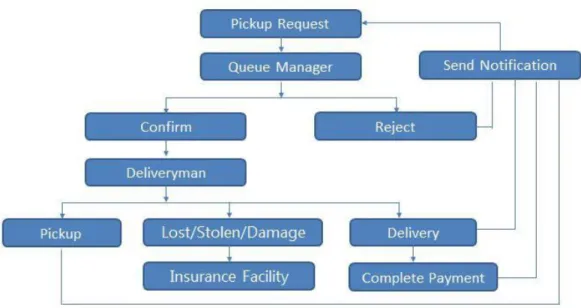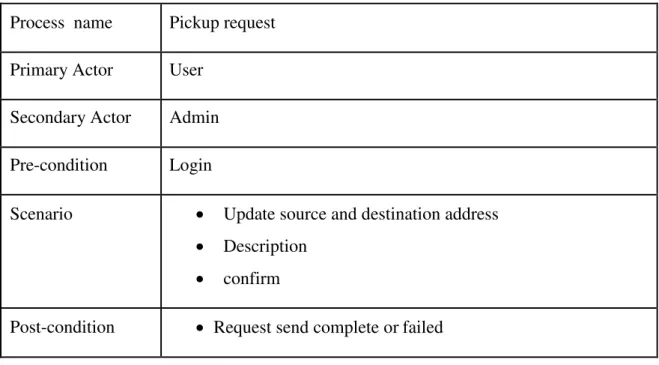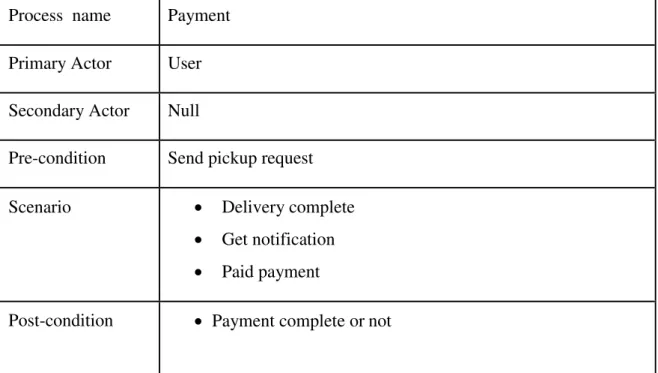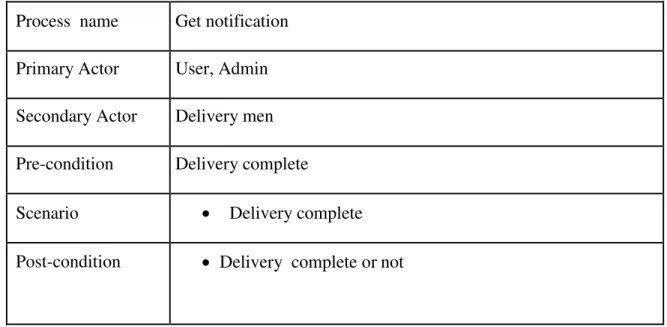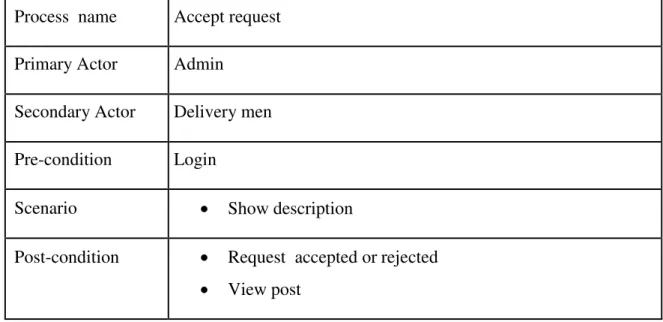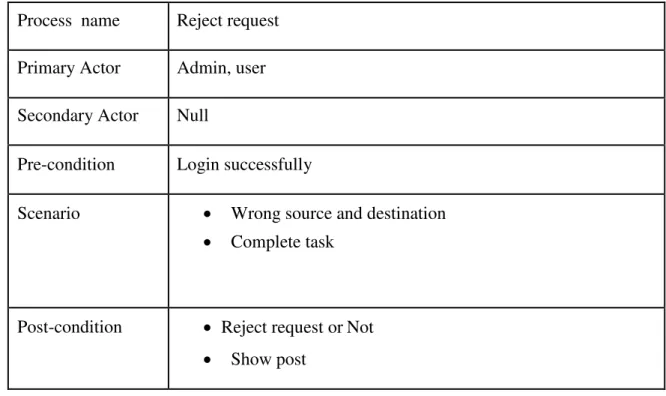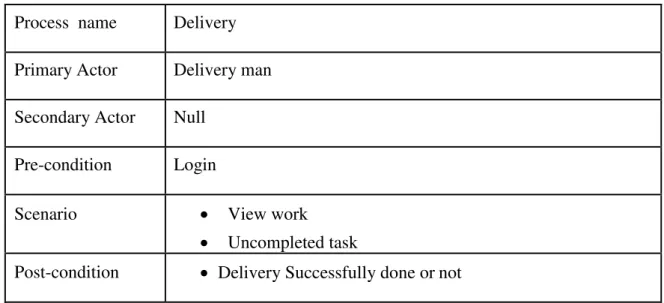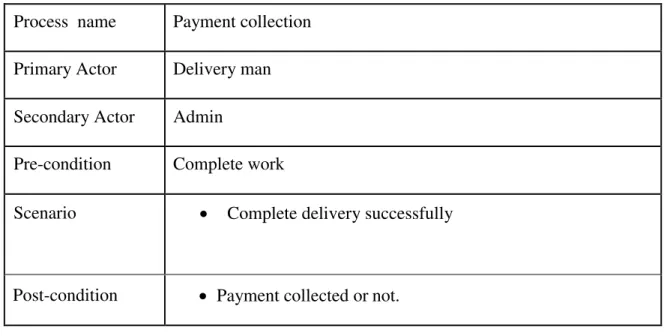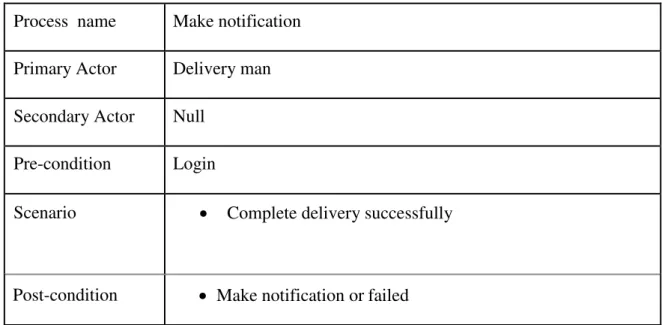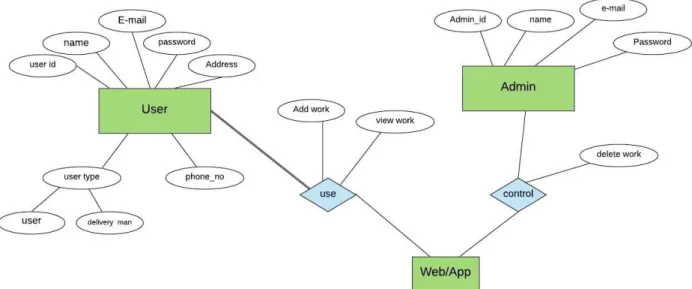MD. MARUF HOSSAIN ID: 163-15-8312
SONJOY DATTA ID: 163-15-8433
RAFIKA NASRIN ID: 163-15-8378
This Report Presented in Partial Fulfillment of the Requirements for the Degree of Bachelor of Science in Computer Science and Engineering
Supervised By
MD. Sazzadur Ahamed Senior Lecturer
Department of CSE
Daffodil International University
Co-Supervised By Al-Amin Hossain
Lecturer Department of CSE
Daffodil International University
DAFFODIL INTERNATIONAL UNIVERSITY
DHAKA, BANGLADESH Summer-2019 E-COURIER SERVICES
BY
DECLARATION
We hereby declare that, this project has been done by us under the Co-supervisor supervision of Md. Sazzadur Ahamed, Senior Lecturer Department of CSE Daffodil International University. We also declare that neither this project nor any part of this project has been submitted elsewhere for award of any degree or diploma.
Supervised by:
Md.Sazzadur Ahamed Senior Lecturer
Department of CSE
Daffodil International University Co-Supervised by:
Al-Amin Hossain Lecturer
Department of CSE
Daffodil International University
Submitted by:
Md. Maruf Hossain ID: 163-15-8312 Department of CSE
Daffodil International University
Sonjoy Datta ID: 163-15-8433 Department of CSE
Daffodil International University Rafika Hasan
ID: 163-15-8378 Department of CSE
Daffodil International University
ACKNOWLEDGEMENT
First i express my heartiest thanks and gratefulness to almighty Allah for His divine blessing makes me possible to complete the final year project successfully.
We really grateful and wish my profound my indebtedness to Md. Sazzadur Ahamed, Senior Lecturer, Department of CSE Daffodil International University, Dhaka. Deep Knowledge & keen interest of my supervisor in the active learning model design influenced to carry out this project.
His endless patience, scholarly guidance, continual encouragement, constant and energetic supervision, constructive criticism, valuable advice, reading many inferior draft and correcting them at all stage have made it possible to complete this project.
We would like to express our heartiest gratitude to Professor Dr. Yousuf Mahbubul Islam, Hon’ble Vice Chancellor and to Dr. Sayed Akhter Hossain, Professor & Head, Department of CSE, for their kind help to finish our project and also to other faculty members and the staffs of CSE department of Daffodil International University.
We would like to thank our entire course mate in Daffodil International University, who took part in this discuss while completing the course work. Finally we must acknowledge with due respect the constant support and patients of our parents.
ABSTRACT
Nowadays, several online courier services that give many benefits to the user. An online courier service is a service in which customers arrive at a request for their parcel. By this project we want to make a new open work place like pathao, uber and others online services. In our application any one can work by registration and authorized process. We hope that one day it become more essential work place to everyone for passing their leisure period. Our online courier service is an Android and web-based Courier Management System, which supports the high availability of courier services to the business and to the customer. The system is getting used for day to day activities Such as booking a courier, maintain hub details, and maintain company details, method knowledge of Companies and plenty of alternative things. Online courier service is programmed using Java technologies. Online courier service may be customized to suit your business and may either be used as an entire system or as separate modules.
TABLE OF CONTENTS
CONTENTS
PAGEBoard of examiners i
Declaration ii
Acknowledgements iii
Abstract iv
Table of contents v-vii
List of figures vii
List of tables viii
CHAPTER
CHAPTER 1: INTRODUCTION 1-3
1.1Introduction 1
1.2Motivation 1
1.3Objectives 1
1.4Expected Outcome 2
1.5Report Layout 2-3
CHAPTER 2: BACKGROUND 4-5
2.1Introduction 4
2.2Comparative Studies 4
2.3Scope of our Project 4
2.4Challenges 5
2.5Time Scheduling 5
CHAPTER 3: REQUIREMENT SPECIFICATION 6-13
3.2 Requirement Collection and Analysis 7
3.3 Use Case Modeling And Description 8
3.3.1 Use Case Modeling And Description 9-13
3.4 Logical Data Model 14
3.5 Design Requirements 3.6 Object modeling 3.7 State Diagram
3.8 Sequence Diagram 14
15 16 17
CHAPTER 4: DESIGN SPECIFICATION 18-22
4.1 Front-end-Design 18
4.1.1 Home Page 18-19
4.1.2 Registration 19
4.1.3 Login 20
4.1.4 Authority Dashboard 20
4.2 Back-end Design 21
4.3 Interaction Design and UX 22
4.4 Implementation Requirements 22
CHAPTER 5: IMPLEMENTATION AND TESTING 23-29
5.1 Implementation of Database 23-24
5.2 Implementation of Front-end Design 25
5.3 Implementation of Interactions 25
5.4 Testing Implementation 26
5.5User Acceptance Testing 5.6 Test Results and Reports
27-28 28-29 CHAPTER 6: CONCLUSION AND FUTURE SCOPE 30
6.1 Discussion and conclusion 30
6.2 Scope for Further Development 30
CHAPTER WRITING STYLE
REFERENCES 31
APPENDIX 32
LIST OF FIGURES
FIGUREPAGE NO Figure 3.1: E-courier Courier Service working process 6
Figure 3.2: Use Case Model Diagram 8
Figure 3.3: E-R Data Model
Figure 3.6: E-courier Courier Service Object Modeling Figure 3.4: E-courier Courier Service state diagram Figure 3.5: E-courier Courier Service state diagram
14 15 16 17
Figure 4.1: Home page in Mobile layout 18
Figure 4.2: Home Page in Desktop layout 19
Figure 4.3: Registration 19
Figure 4.4: Login 20
Figure 4.5: Admin Panel 20
Figure 5.1: Database 23
Figure 5.2: Database 24
LIST OF TABLES
TABLES PAGE NO
Table 3.1: Use case description of registration 9
Table 3.2: Use case description of login 9
Table 3.3: Use case description of pickup request 10
Table 3.4: Use case description of payment 10
Table 3.5: Use case description of get notification 11
Table 3.6: Use case description of Accept request 11
Table 3.7: Use case description of reject request 12
Table 3.8: Use case description of delivery 12
Table 3.9: Use case description of payment collection Table 3.10: Use case description of make notification
13 13 Table 5.1: Test case evaluation
Table 5.2:Comparative Study Table 5.3: User study result
26 27 28
1.1 Introduction
CHAPTER 1 INTRODUCTION
This E-courier Service project can have totally different modules. The login section can have login facility for the admin WHO can operate this method and on-line chase system of consignment and shipping detail for domestic shipping. While taking orders from its customers, it'll take all the main points of its customers WHO is putting the orders and every one the main points for the recipient like its address, name, mobile number. During request method, system generates a consignment range for his or her product. Through this consignment no. customers or its recipient can able to track their product from any location by using internet. This online courier System project can give data recipient with following detail – wherever the present consignment is, Till once it'll reached its final destination, date of putting consignment, final date to succeed in its destination etc.
1.2 Motivation of work
• Our mission is to provide suitable delivery system to our users or any company with an eco-friendly way.
• As well as providing the general and premium service to the valuable users/company with digital tracking system.
• Its advanced tracking software enables customers to track their parcel's current location anytime.
So we made “Online House Rent System” where every person can getting all kinds of rent equipment for rent using internet browsing of our site” [7] [8].
1.3 Objectives of the software:
To create an open working source for everyone.
To produce an entire user friendly service-based application and web site whose primary priority is to satisfy user’s demands and expectations.
The utilization of e-courier by the highest most e-commerce and business professionals and single user likewise.
1.4 Expected Outcome
Online system is a browser based system and to develop online the developer may select any tool for doing it.
• The research data will be used for developing an web application.
• Users/Company can easily find out our courier services for themselves.
• It will be possible to get good courier services at a short time with low cost.
• Also, there will be an insurance system. Insurance facilities will be applied when users/companies product will be lost, stolen and damage cases.
1.5 Report Layout
Chapter 1: Introduction
In this chapter we've got mentioned regarding the motivation, objectives and also the expected outcome for this system.
Chapter 2: Background
In this part of our project report we spoke about our project background. We tend to conjointly bring up the connected job, balance to alternative examinee method, and the scope of the matter and challenges of the project.
Chapter 3: Requirement Specification
This part of our project report we are going to regarding all the necessities like data flow diagram, collect requirements and analysis, use case model, Object modeling, State Diagram, Sequence Diagram of our project and the description of use case, the logical relational database model and therefore the style needs for our project.
Chapter 4: Design Specification
That section of our project report we discus total style of our system as example Front-end design, back-end design, interaction design and the embodiment demanded. All that things are very important for our project.
Chapter 5: Implementation and Testing
This part of the system report we contain the creation method of database, front-end designs, interactions and the test results for our system.
Chapter 6: Conclusion and Future Scope of our project
In the part of our project report we have discussed the perfecting and discuss about our project future development much need about this system upgrade.
CHAPTER 2 BACKGROUND 2.1 Introduction
The idea behind the proposed application and website is to develop consistent, robust and user – friendly software that allows visitors and customers to send any kind of things as per his/her requirement, for required duration and in any of the selected cities. This service will provided for every people whose need to send their parcel, document and small gift box, etc.
And this service is also for the people who want to work and earn their free time. Alongside their study or job.
2.2 Comparative Studies
Our executed mobile application and website is dissimilar from the live all website’s. Every registered user can post ads for their parcel and document . Every people getting all kinds of courier information using our application and websites. The proposed courier system maintenance is easier for users. It is not delay process; it is very faster system and user friendly. Users easily registration and create her/his profile, login, post ads. This online courier system provides any kind of courier services and also delivery men would be able to easily find their work. Example small parcel, important document, gift box, home delivery, office equipment, etc.
2.3 Scope of our Project
It is an open working place where people do join and work.
In our application where all users can interact easily with us and our support.
Users able to easily create account and log in then they can get access.
Admin can distribute all users’ access for work post and view.
Users can post work and need to information search for work.
2.4 Challenges
Admin has to define users can get access or rejected.
Admin control the whole database and save from unauthorized access.
Individual work are shown to all delivery men and the user who post that work.
There are no privacy level when it comes to posting or submitting assignments.
Most important challenge is use Google map API access for source and destination.
2.5 Time schedule
First we analysis about requirements in 15 days.
Then collect we our requirements in 1.5 mounts.
Complete design part in 1.5 mounts.
Complete coding in 3.5 mounts.
Then we test our full system in 15 days.
Total time 7.5 mounts for our system implement.
CHAPTER 3
REQUIREMENT SPECIFICATION
3.1 E-courier service work process
In our project we have made a processing model. By that we can understand the whole process of our Online Courier Service System.
Figure 3.1: E-courier Courier Service working process
3.2 Requirement Collection & Analysis
Here we discuss about how we collect requirements for out project and how we implement that requirements throughout place in our software.
Want to edit the blog post information.
View the single blog post.
Specify the users post separately.
Needed to a create account for log in.
Needed a valid email to reset the password and further actions.
Admin needed the access to delete and add work.
User needed his/her work access to edit and delete work.
3.3 Use Case Modeling and Description
A diagram that shows a set of process and actors and their relationship .use case represent system functionality, their requirements, and the requirements of the system from the user perspective.
Figure 3.2: Use Case Model Diagram
3.3.1 Use Case Description
Table 3.1: Description of registration Process name Registration Primary Actor User, delivery men Secondary Actor Admin
Pre-condition Null Scenario
Submit valid email address
Submit password minimum of 6 character
Select a role
Post-condition User Registration complete or failed
Table 3.2: Description of login Process name Login
Primary Actor User, delivery men Secondary Actor Admin
Pre-condition Registration
Scenario Submit valid email address
Submit password
Post-condition User Login complete or failed
Table 3.4: Description of Pickup request
Table 3.3: Description of Payment Process name Pickup request Primary Actor User
Secondary Actor Admin Pre-condition Login
Scenario Update source and destination address
Description
confirm
Post-condition Request send complete or failed
Process name Payment Primary Actor User Secondary Actor Null
Pre-condition Send pickup request
Scenario Delivery complete
Get notification
Paid payment
Post-condition Payment complete or not
Table 3.5: Description of get notification Process name Get notification Primary Actor User, Admin Secondary Actor Delivery men Pre-condition Delivery complete
Scenario Delivery complete
Post-condition Delivery complete or not
Table 3.6: Description of Accept request Process name Accept request Primary Actor Admin
Secondary Actor Delivery men Pre-condition Login
Scenario Show description
Post-condition Request accepted or rejected
View post
Table 3.7: Description of Reject request Process name Reject request Primary Actor Admin, user Secondary Actor Null
Pre-condition Login successfully
Scenario Wrong source and destination
Complete task
Post-condition Reject request or Not
Show post
Table 3.8: Description of Delivery
Process name Delivery Primary Actor Delivery man Secondary Actor Null
Pre-condition Login
Scenario View work
Uncompleted task
Post-condition Delivery Successfully done or not
Table 3.9: Use case description of Payment collection
Process name Payment collection Primary Actor Delivery man Secondary Actor Admin
Pre-condition Complete work
Scenario Complete delivery successfully
Post-condition Payment collected or not.
Table 3.10: Use case description of make notification
Process name Make notification Primary Actor Delivery man Secondary Actor Null
Pre-condition Login
Scenario Complete delivery successfully
Post-condition Make notification or failed
3.4 Logical Data Model
Figure 3.3: E-courier Courier Service Logical data model
3.5 Design Requirements
There are 3 categories of users here they are Admin, User and Delivery man both are user.
User and Delivery man will create an account.
User submits his/her work.
Delivery man search location wised.
Delivery men see all the post and get all information.
User change or delete his/her work.
Admin maintain all access.
Admin can delete post.
Every user view all post.
3.6 Object modeling
Object Modeling is a general framework for designing information systems. It focuses in objects, the actions they perform and the messages they send to one another to cause those actions to be taken”[5].
Figure 3.3: E-courier Courier Service Object Modeling
3.7 State Diagram
A state diagram is a type of diagram used in computer science and related fields to describe the behavior of systems. State diagrams require that the system described is composed of a finite number of states”[6].
Figure 3.4: E-courier Courier Service state diagram
3.8 Sequence Diagram
A sequence diagram shows object interactions arranged in time sequence. It depicts the objects and classes involved in the scenario and the sequence of messages exchanged between the objects needed to carry out the functionality of the scenario”[6].
Figure 3.5: E-courier Courier Service state diagram
4.1 Front-end Design:
CHAPTER 4
DESIGN SPECIFICATION
The Front-end style is that the illustration of a computer code. This can be the approach of interaction approach between the users and therefore the servers. Front-end style is thought as a client-side development. Within the most facet of a computer code development the foremost vital half is to style the front-end. we have a tendency to create an easy front-end style for the users to co-operate with the computer code simply. Here ar some front-end style of our computer code given below.
4.1.1 Home Page:
In our mobile application and web page there is a menu bar, there have some option for users that is add work, view work, delete work, check work. And the delivery men also view the work .they can deliver the parcel when they view the uncompleted work.
Figure 4.2: Home page in desktop layout 4.1.2Registration page:
That is the registration page of our mobile application, there is no registration page in our website. Were all users done their registration; they are user and delivery men. In registration page user need some important data for complete their registration.
Figure 4.3: Registration
4.1.3Login page:
Here is our web login page. The pages have the entire thing that should be in a login page. A login use a User for visit this site and a delivery boy for work.
Figure 4.4: Login Page
4.1.4
Authority Dashboard:
4.2 Back-end Design:
The logical a part of a computer code implement within the back-end. It’s the foremost necessary a part of a computer code. The full system depends on that. Sometimes back-end refers developer aspect. In back-end there are a unit several issue consists just like the scripting languages or the server aspect language, automatic framework, direction, security, authentication, authorization, information parsing, data confirmatory, information backups so on. We have a tendency to developed “Online courier Service” web site exploitation PHP and JavaScript. We have a tendency to conjointly use java language for our mobile application. In here all the logical factor and also the hosting web site offer us the firebase info for saving the info} information and also the work flow of the computer code” [4].
4.3 Interaction Design and UX
We planned our mobile application by using android studio and we also planned our web software using bootstrap framework. This 2 framework gives us the good optical for our project what user wants, and they give us the responsive web based application. we have to increase our user and we follow this process that is how user satisfaction with our application's user interface, usability, accessibility, in our mobile application and web based application.”. “Developer main target is to draw maximum users. For this, developers make an attractive interface that makes application more user friendly. Different types of styles are used to make better user experience.”
4.4 Implementation of Requirements
We implemented our mobile application and web application design by using java and raw PHP.
We used Firebase for mobile and web application Database.
When a user failed to login then it will be stored into the database.
SQL injection needed to protect with string escaping.
For a user validation we use java language and JavaScript.
CROSS-SITE-SCRIPTING is mandatory to verify.
We have to prevent unauthorized user in high attach limit.
When a user input invalid data for login or sign up then an error message will be on display.
For specific design we have used Jquery that is very important for our application.
We have a website and it should be responsive, for responsive website we must use
CHAPTER 5
IMPLEMENTATION AND TESTING
5.1 Implementation of Database
Because of using mobile application in Android and web both we had to use firebase database. Firebase is the controller of data base model. For that we don't need to direct sql query for our database to performed actions. In this model data must be check that user can be able to input data into database. We used Google firebase for DBMS. There are some tables in our DBMS which are
Users Registration Table: Information’s such as full name, email, password, mobile and status like Owner and Customer are saved in this table.
Figure 5.1: Database
Password Resets Table: If users ever forget their account password, they can regain their account access by resetting password. Here a generated token and email address of that user is saved.
Ads Post Table: Information such as work type, title, division, city, information, post- date, status which that owner user is saved.
Figure 5.2: Database
5.2 Implementation of Front-end Design
It is quite difficult make a simple UI design for the users, we try making as simple as possible. Nowadays, many people use smart phone for their work simple and they also used many other types of devices as tablets, desktop, laptop and so on. That’s why we make a mobile application for mobile user and we also make a web base application for other users.
Our website is fully responsible for all kind of devices. We make our mobile applications interface standard by using use android studio, and we used HTML, CSS, and JQuery for our web application”[1] [3].
Here some factors of performing the front-end design
In this system we have 3 categories user they are Admin, user and delivery men.
Every user should have completed their registration.
For login user must have to use their registered email and password.
When user forgets his/her password then they can reset their password.
When a user wants to update his/her profile information then he must have given his/her password.
5.3 Implementation of Interactions
For our (E-courier services) project we implemented a user friendly interface for our user. For a user friendly interface we used icon, images, text link and button. The front end design of our web software is user friendly. Both Admin and Users and delivery men will need to create profile for access our web and mobile application.
5.4 Testing Implementation
When we implement a system then we must have it to test that system, in the test result tester can see the test result .how the system work and does the system work properly.
Table 5.1: Test case evaluation
Test Case number
Input Expected outcome
Outcome Result Tested on
Empty name, Pass 07-27-2019
1.Registration email, status, password,
Fill all the fields with valid data
Fill all the fields
mobile
2. Login Registered email and
Successfully Pass 07-27-2019
password login Login complete
3. Password Incorrect Warning the Password is incorrect
Pass 07-27-2019 password Password is
incorrect
4. Login Registered email And
Wrong password
Email or password is incorrect
Email or password is wrong
Pass 07-27-2019
5. Ads Post password Successfully Add post
Add post successfully
Pass 07-27-2019
5.5 User Acceptance Testing:
The table below summarize the test cases employed for user acceptance testing and the test result obtained for each test case”[7] [8].
Table 5.2: comparative study
1. e-courier bd Only have website
Offline service
They don’t have mobile application
Not open work source
2.sonarcourier.com Only have website
Offline service
They don’t have mobile application
Not open work source
3.rapido.com Only have website
Offline service
They don’t have mobile application
Not open work source
Questions for some users:
1. UI was user friendly?
2. Do you think you found the two or more information you needed as expected?
3. Do you think current system was easier than other system?
Answer:
Table 5.3: user study result
User Question
1
Question 2
Question 3
1 yes yes yes
2 no yes yes
3 yes yes yes
4 yes yes no
5 yes yes yes
6 no yes yes
7 yes yes no
The test report must be clear and the report will be in a particular manner , which bargains a chance to calculation testing results fast. This is the final document that records the data from associative analysis in an organized manner, it recounts to the system environmental condition,
it's compare the check result with the check objectives.
The test report is very important for known that the system we implement that is ready or not for work. The testing data will be recorded by a document from an analysis experiment .the
system will run various test.
Here some type of testing a system:
Functionality
Regression
Security
Performance
Scalability
Usability
System interoperability
Localization
Disaster recovery
Installation.
When a system will passed the all test then the system will be able to launch So the end of test we can carry our system test result as benefit of testing.
The quality of our application is very good.
The system of our application is more easier to other system for use.
your application is very acceptable by user.
It is very easy for new user.
Good UI for interaction.
CHAPTER 6
CONCLUSION AND FUTURE SCOPE 6.1 Discussion and Conclusion
• Mobile application and the Web based application is the magic of today’s world.
• The object of “e-Courier Services” project is to harness the power of internet for our practical and potential one.
• The basic idea of this project is to explain the fundamental concepts of C2B (Customer to business) services.
• We hope that the users as well as the companies would maximum utilize of our project We keep on adding new facilities which would make it very useful for other discipline persons among other industries
6.2 Scope for Further Developments
We have some limitation now soon we will try to reduce our limitation as much as possible.
Convert to Mobile application.
Provide nationwide service. Initially, it will work based on Dhaka city only.
Online payment system integration. Initially, it will work with local payments/cash on delivery.
Integrate live chat to solve problem quickly.
Available 24/7 365 days a year.
REFERENCES
[1] User experience design, available at <https://en.wikipedia.org/wiki/User_experience_design>, last accessed 03.02.2019 at 12:40 pm
[2] UX Curve: A method for evaluating long-term user experience, available at
<https://doi.org/10.1016/j.intcom.2011.06.005>, last accessed 03.06.2019 at 1:50 pm
[3] Basic website design code HTML,PHP and bootstrap, available at <http://www.w3schools.com/sql/> last accessed 13.02.2019 at 1:50
[4] Raw PHP code, available at <http://php.net/> last accessed 18.03.2019 at 9:50 pm
[5] Object diagram modeling, available at <http://www.bernstein-plus-
sons.com/.dowling/POCSF07/Object_Modeling.html> last accessed 15.04.2019 at 1:50 pm
[6] use case design, available at <https://www.lucidchart.com/documents/edit/649f6d44-a622-4d8d-af66- 3248e9912402/0> last accessed 18.03.2019 at 3:00 pm
[7] State diagram design, available at <https://www.lucidchart.com/documents/edit/649f6d44-a622-4d8d-af66- 3248e9912402/0> last accessed 18.03.2019 at 4:30 pm
[8] ecourierbd, available at <http://www.ecourier.com.bd/> last accessed 14.04.2019 at 1:40 pm [9] sonarcourier, available at <https://sonarcourier.com/> last accessed 14.04.2019 at 2:00 pm [10]rapido, available at <https://www.rapido.com.bd/> last accessed 15.04.2019 at 2:20 pm
APPENDIX Project Reflection:
This project “E-courier service System” will be very helpful for both admin and users to communicate. The user will be more facilities for need to take a parcel in anywhere in Dhaka city. User will take proper information of he/she want for courier. our admin and delivery men will be work together and they will be able to contact with each other when they need to talk for the work and they will solve all of the problem of our courier and they also maintain their good relationship and good understanding for future.
E-COURIER final
ORIGINALITY REPORT
27 %
SIMILARITY INDEX
7 %
INTERNET SOURCES
0 %
PUBLICATIONS
27 %
STUDENT PAPERS
PRIMARY SOURCES
Submitted to Daffodil International University
Student Paper
www.sciencepub.net
Internet Source
1croreprojects.com
Internet Source
Submitted to Myanmar Computer Company Ltd (MCC) - Yatanarpon
Student Paper
www.slideshare.net
Internet Source
Submitted to Southern New Hampshire University - Continuing Education
Student Paper
Submitted to Intercollege
Student Paper
Submitted to Colorado Technical University Online
19 % 2 % 1 % 1 %
1 % 1 %
1 % 1 %
8
7
6
5
4
3
2
1
Submitted to Informatics Education Limited
Student Paper
10 Submitted to University of Wolverhampton
Student Paper
11 Submitted to Higher Education Commission Pakistan
Student Paper
< 1 %
< 1 %
< 1 %
Exclude quotes Off Exclude bibliography Off
Exclude matches Off
